Small overlap front: driver-side
Rating applies to 2022-23 models
Tested vehicle: 2022 Jeep Wrangler Unlimited Sport 4-door 4wd
The Jeep Wrangler was redesigned for the 2018 model year. The previous design was built concurrently through much of the same model year and was renamed the Wrangler JK. Beginning with 2022 models, changes were made to the front structure to prevent tipping in small overlap crashes.
In the Institute's test, the vehicle tipped onto its passenger side after striking the barrier. The partial rollover presents an additional injury risk beyond what the standard criteria are intended to measure in small overlap frontal crash tests. A vehicle tipping onto its side is not an acceptable outcome for a frontal crash and, as a result, the Wrangler's overall rating was downgraded to marginal. These ratings also apply to the Jeep Gladiator.
| Evaluation criteria | Rating |
|---|---|
| Structure and safety cage | |
| Driver injury measures | |
| Head/neck | |
| Chest | |
| Hip/thigh | |
| Lower leg/foot | |
|
Driver restraints and dummy kinematics
| |
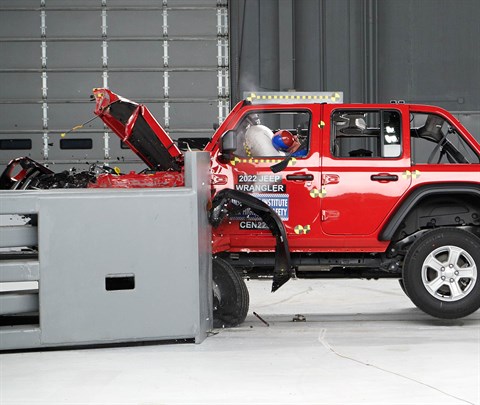
Action shot taken during the driver-side small overlap frontal crash test just before the vehicle tipped on its side.
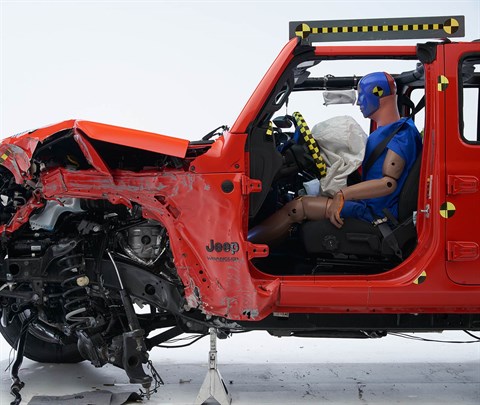
The dummy's position in relation to the door frame, steering wheel, and instrument panel after the crash test indicates that the driver's survival space was maintained very well.
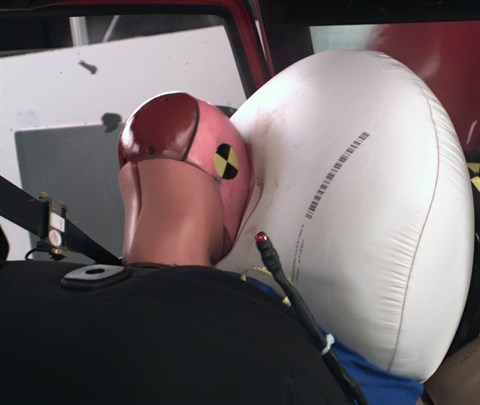
The dummy’s movement was well controlled. The dummy’s head loaded the frontal airbag, which stayed in front of the dummy until rebound. The combination head and torso side airbag did not deploy during the test. The vehicle lacks side curtain airbags.
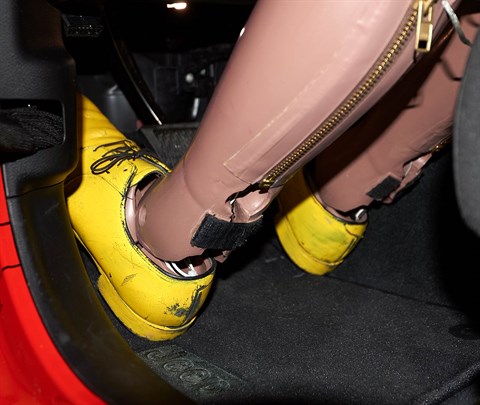
Forces during the crash contributed to a significant risk of injury to the dummy's left lower leg/foot.
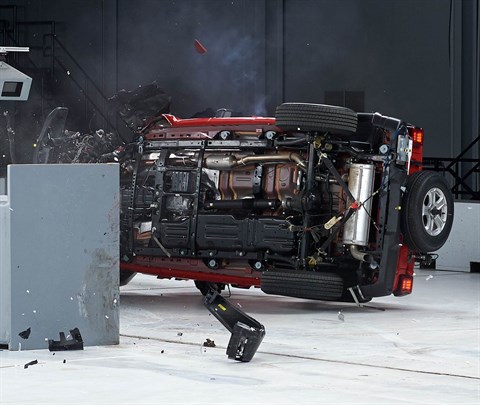
The partial rollover presents an additional injury risk beyond what the standard crash test criteria are intended to measure.
Measures of occupant compartment intrusion on driver side
| Evaluation criteria | Measurement |
|---|---|
| Test ID | CEN2204 |
| Lower occupant compartment | |
| Lower hinge pillar max (cm) | 2 |
| Footrest (cm) | 8 |
| Left toepan (cm) | 9 |
| Brake pedal (cm) | 6 |
| Parking brake (cm) | |
| Rocker panel lateral average (cm) | 1 |
| Upper occupant compartment | |
| Steering column | 3 |
| Upper hinge pillar max (cm) | 3 |
| Upper dash (cm) | 3 |
| Lower instrument panel (cm) | 4 |
Driver injury measures
| Evaluation criteria | Measurement |
|---|---|
| Test ID | CEN2204 |
| Head | |
| HIC-15 | 209 |
| Peak gs at hard contact | no contact |
| Neck | |
| Tension (kN) | 1.4 |
| Extension bending moment (Nm) | 16 |
| Maximum Nij | 0.28 |
| Chest maximum compression (mm) | 30 |
| Femur (kN) | |
| Left | 3.3 |
| Right | 0.6 |
| Knee displacement (mm) | |
| Left | 5 |
| Right | 0 |
| Knee-thigh-hip injury risk (%) | |
| Left | 1 |
| Right | 0 |
| Maximum tibia index | |
| Left | 0.92 |
| Right | 0.33 |
| Tibia axial force (kN) | |
| Left | 10.4 |
| Right | 1.9 |
| Foot acceleration (g) | |
| Left | 195 |
| Right | 32 |
Moderate overlap front: original test
Rating applies to 2021-23 models
Tested vehicle: 2018 Jeep Wrangler Unlimited Sahara 4-door 4wd
The Jeep Wrangler was redesigned for the 2018 model year. The previous design was built concurrently through much of the same model year and was renamed the Wrangler JK. Moderate overlap frontal ratings are assigned by the Institute based on a test conducted by Fiat Chrysler and apply only to the redesigned model. These ratings also apply to the Jeep Gladiator.
| Evaluation criteria | Rating |
|---|---|
| Overall evaluation | |
| Structure and safety cage | |
| Driver injury measures | |
| Head/neck | |
| Chest | |
| Leg/foot, left | |
| Leg/foot, right | |
| Driver restraints and dummy kinematics | |
Measures of occupant compartment intrusion on driver side
| Evaluation criteria | Measurement |
|---|---|
| Test ID | VTF1918 |
| Footwell intrusion | |
| Footrest (cm) | 3 |
| Left (cm) | 9 |
| Center (cm) | 16 |
| Right (cm) | 17 |
| Brake pedal (cm) | 12 |
| Instrument panel rearward movement | |
| Left (cm) | 1 |
| Right (cm) | 2 |
| Steering column movement | |
| Upward (cm) | 2 |
| Rearward (cm) | 1 |
| A-pillar rearward movement (cm) | 0 |
Driver injury measures
| Evaluation criteria | Measurement |
|---|---|
| Test ID | VTF1918 |
| Head | |
| HIC-15 | 297 |
| Peak gs at hard contact | no contact |
| Neck | |
| Tension (kN) | 1.0 |
| Extension bending moment (Nm) | 14 |
| Maximum Nij | 0.20 |
| Chest maximum compression (mm) | 37 |
| Legs | |
| Femur force - left (kN) | 0.2 |
| Femur force - right (kN) | 0.2 |
| Knee displacement - left (mm) | 0 |
| Knee displacement - right (mm) | 1 |
| Maximum tibia index - left | 0.36 |
| Maximum tibia index - right | 0.58 |
| Tibia axial force - left (kN) | 3.0 |
| Tibia axial force - right (kN) | 2.5 |
| Foot acceleration (g) | |
| Left | 117 |
| Right | 84 |
Moderate overlap front: updated test
Rating applies to 2022-23 models
Tested vehicle: 2022 Jeep Gladiator Altitude Crew Cab 4wd
The Jeep Gladiator, the first pickup in Jeep's lineup, was introduced for the 2020 model year.
| Evaluation criteria | Rating |
|---|---|
| Overall evaluation | |
| Structure and safety cage | |
| Driver injury measures | |
| Head/neck | |
| Chest | |
| Thigh/hip | |
| Leg/foot | |
| Driver restraints and dummy kinematics | |
| Rear passenger injury measures | |
| Head/neck | |
| Chest | |
| Thigh | |
|
Rear passenger restraints and dummy kinematics
| |

View of the vehicle after the crash showing the front driver airbag and damage to the occupant compartment. The driver combination head and torso side airbag did not deploy during the test. The vehicle lacks a side airbag in the rear.
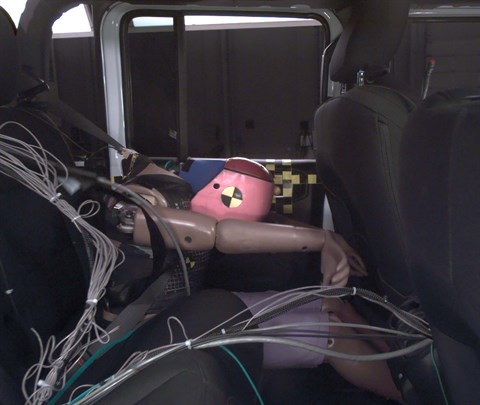
The rear passenger dummy's head remained a safe distance from the front seatback.
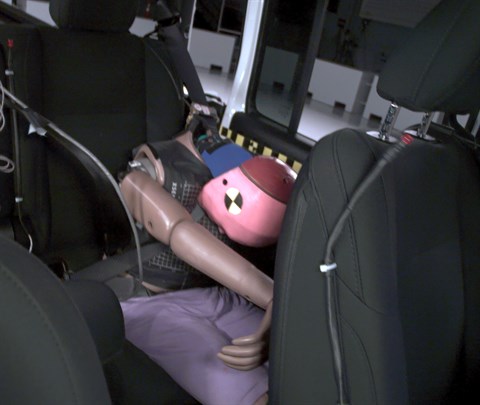
Rear passenger dummy injury values indicate a moderate risk of injury to the head or neck and a likely risk of injury to the chest. During the crash, the shoulder belt remained in an ideal position on the dummy’s chest.
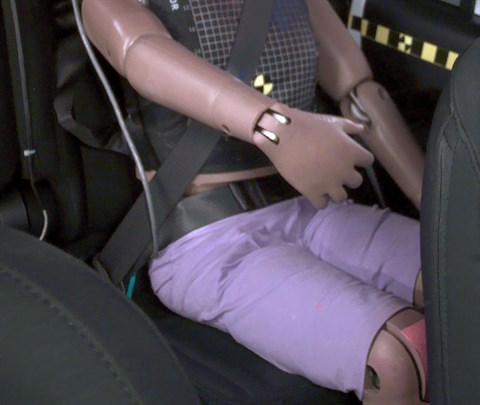
The rear passenger dummy's lap belt remained in the ideal position on the pelvis.
Measures of occupant compartment intrusion on driver side
| Evaluation criteria | Measurement |
|---|---|
| Test ID | CEF2219 |
| Footwell intrusion | |
| Footrest (cm) | 3 |
| Left (cm) | 5 |
| Center (cm) | 7 |
| Right (cm) | 12 |
| Brake pedal (cm) | 5 |
| Instrument panel rearward movement | |
| Left (cm) | 0 |
| Right (cm) | 0 |
| Steering column movement | |
| Upward (cm) | 0 |
| Rearward (cm) | -4 |
| A-pillar rearward movement (cm) | 1 |
Driver injury measures
| Evaluation criteria | Measurement |
|---|---|
| Test ID | CEF2219 |
| Head | |
| HIC-15 | 181 |
| Peak gs at hard contact | no contact |
| Neck | |
| Tension (kN) | 1.3 |
| Extension bending moment (Nm) | 14 |
| Maximum Nij | 0.21 |
| Chest maximum compression (mm) | 39 |
| Femur (kN) | |
| Left | 0.9 |
| Right | 0.4 |
| Knee displacement (mm) | |
| Left | 1 |
| Right | 0 |
| Knee-thigh-hip injury risk (%) | |
| Left | 0 |
| Right | 0 |
| Maximum tibia index | |
| Left | 0.38 |
| Right | 0.36 |
| Tibia axial force (kN) | |
| Left | 4.1 |
| Right | 3.1 |
| Foot acceleration (g) | |
| Left | 101 |
| Right | 110 |
Rear passenger injury measures
| Test ID | CEF2219 |
|---|---|
| Head | |
| HIC-15 for head contact during forward excursion |
no contact
|
| Peak gs at hard contact | no contact |
| Neck | |
| Tension (kN) | 2.7 |
| Compression (kN) | 0.7 |
| Maximum Nij for head contact during forward excursion |
no contact
|
| Chest | |
| Chest index | 44 |
| Shoulder belt tension (kN) | 6.6 |
| Thigh (kN) | |
| Left femur compression | 2.0 |
| Right femur compression | 2.3 |
Side: updated test
Rating applies to 2022-23 models
Tested vehicle: 2023 Jeep Gladiator Sport Crew cab 4wd
The Jeep Gladiator, the first pickup in Jeep's lineup, was introduced for the 2020 model year. Side 2.0 ratings are assigned by the Institute based on a test of a 2023 Gladiator conducted by Stellantis.
| Evaluation criteria | Rating |
|---|---|
| Overall evaluation | |
| Structure and safety cage | |
| Driver injury measures | |
| Head/neck | |
| Torso | |
| Pelvis | |
| Driver head protection | |
| Rear passenger injury measures | |
| Head/neck | |
| Torso | |
| Pelvis | |
|
Rear passenger head protection
The dummy's head contacted the soft top vertical support and rear door window frame. The vehicle also lacks a side airbag in the rear. The head protection is inadequate. | |
Measures of occupant compartment intrusion on driver side
| Evaluation criteria | Measurement |
|---|---|
| Test ID | VTS2315 |
| B-pillar to longitudinal centerline of driver's seat (cm) | -17.5 |
| Negative numbers indicate the amount by which the crush stopped short of the seat centerline. | |
Driver injury measures
| Evaluation criteria | Measurement |
|---|---|
| Test ID | VTS2315 |
| Head | |
| HIC-15 | 13 |
| Peak gs at hard contact | no data |
| Neck | |
| Tension (kN) | 0.6 |
| Compression (kN) | 0.1 |
| Shoulder | |
| Lateral deflection (mm) | 6 |
| Lateral force (kN) | 0.7 |
| Torso | |
| Maximum deflection (mm) | 7 |
| Average deflection (mm) | 6 |
| Maximum deflection rate (m/s) | 1.36 |
| Maximum viscous criterion (m/s) | 0.04 |
| Pelvis | |
| Combined force (kN) | 2.3 |
Passenger injury measures
| Evaluation criteria | Measurement |
|---|---|
| Test ID | VTS2315 |
| Head | |
| HIC-15 | 99 |
| Peak gs at hard contact | 71 |
| Neck | |
| Tension (kN) | 1.2 |
| Compression (kN) | 0.3 |
| Shoulder | |
| Lateral deflection (mm) | 13 |
| Lateral force (kN) | 0.6 |
| Torso | |
| Maximum deflection (mm) | 14 |
| Average deflection (mm) | 9 |
| Maximum deflection rate (m/s) | 1.18 |
| Maximum viscous criterion (m/s) | 0.08 |
| Pelvis | |
| Combined force (kN) | 3.3 |
Roof strength
Rating applies to 2021-23 models
Tested vehicle: 2019 Jeep Wrangler Unlimited Sport 4-door 4wd
Roof ratings do not apply to the Wrangler JK
| Overall evaluation | |
|---|---|
| Curb weight | 4,239 lbs |
| Peak force | 22,622 lbs |
| Strength-to-weight ratio | 5.34 |
Headlights
Ratings are given for 4 different headlight variations available on this vehicle.
Trim level(s)
- Sport trim equipped with LED Headlamp and Fog Lamp Group and Advanced Safety Group packages
- Overland trim equipped with LED Headlamp and Fog Lamp Group and Advanced Safety Group packages
- Rubicon trim equipped with LED Headlamp and Fog Lamp Group and Advanced Safety Group packages
- Mojave trim equipped with LED Headlamp and Fog Lamp Group and Advanced Safety Group packages
| Evaluation criteria | Rating |
|---|---|
| Low-beam headlight type | LED projector |
| High-beam headlight type | LED projector |
| Curve-adaptive? | No |
| High-beam assist? | Yes |
|
Overall rating | |
| Distance at which headlights provide at least 5 lux illumination: | |
Low beams
On the straightaway, visibility was good on both sides of the road. On curves, visibility was good on both right curves and fair on both left curves.
The low beams created some glare.
High beams
On the straightaway, visibility was inadequate on both sides of the road. On curves, visibility was fair on both right curves and inadequate on both left curves.
High-beam assist compensates for some limitations of this vehicle's low beams on the straightaway and on the gradual left curve.
| Evaluation criteria | Measurement |
|---|---|
| Trim level(s) |
|
| Low-beam headlight type | LED projector |
| High-beam headlight type | LED projector |
| Curve-adaptive? | No |
| High-beam assist? | Yes |
|
Overall rating Applies to 2022-24 models |
| LOW BEAMS | Average minimum useful illumination distance (5 lux) |
Amount glare exceeded threshold |
|---|---|---|
| Straightaway right edge | 101.1 m | None |
| Straightaway left edge | 58.7 m | None |
| 250m radius right curve, right edge | 73.7 m | None |
| 250m radius left curve, right edge | 55.9 m | 41.2% |
| 150m radius right curve, right edge | 58.7 m | 19.4% |
| 150m radius left curve, left edge | 54.5 m | 19.9% |
| HIGH BEAMS | Average minimum useful illumination distance (5 lux) |
|---|---|
| Straightaway right edge | 111.7 m |
| Straightaway left edge | 74.8 m |
| 250m radius right curve, right edge | 73.6 m |
| 250m radius left curve, left edge | 59.2 m |
| 150m radius right curve, right edge | 56.1 m |
| 150m radius left curve, left edge | 53.3 m |
Trim level(s)
- Sport trim equipped with LED Headlamp and Fog Lamp Group package
- Overland trim equipped with LED Headlamp and Fog Lamp Group package
- Rubicon trim equipped with LED Headlamp and Fog Lamp Group package
- Mojave trim equipped with LED Headlamp and Fog Lamp Group package
| Evaluation criteria | Rating |
|---|---|
| Low-beam headlight type | LED projector |
| High-beam headlight type | LED projector |
| Curve-adaptive? | No |
| High-beam assist? | No |
|
Overall rating | |
| Distance at which headlights provide at least 5 lux illumination: | |
Low beams
On the straightaway, visibility was good on both sides of the road. On curves, visibility was good on both right curves and fair on both left curves.
The low beams created some glare.
High beams
On the straightaway, visibility was inadequate on both sides of the road. On curves, visibility was fair on both right curves and inadequate on both left curves.
| Evaluation criteria | Measurement |
|---|---|
| Trim level(s) |
|
| Low-beam headlight type | LED projector |
| High-beam headlight type | LED projector |
| Curve-adaptive? | No |
| High-beam assist? | No |
|
Overall rating Applies to 2022-25 models |
| LOW BEAMS | Average minimum useful illumination distance (5 lux) |
Amount glare exceeded threshold |
|---|---|---|
| Straightaway right edge | 101.1 m | None |
| Straightaway left edge | 58.7 m | None |
| 250m radius right curve, right edge | 73.7 m | None |
| 250m radius left curve, right edge | 55.9 m | 41.2% |
| 150m radius right curve, right edge | 58.7 m | 19.4% |
| 150m radius left curve, left edge | 54.5 m | 19.9% |
| HIGH BEAMS | Average minimum useful illumination distance (5 lux) |
|---|---|
| Straightaway right edge | 111.7 m |
| Straightaway left edge | 74.8 m |
| 250m radius right curve, right edge | 73.6 m |
| 250m radius left curve, left edge | 59.2 m |
| 150m radius right curve, right edge | 56.1 m |
| 150m radius left curve, left edge | 53.3 m |
Trim level(s)
- Sport trim equipped with Advanced Safety Group package
- Overland trim equipped with Advanced Safety Group package
- Rubicon trim equipped with Advanced Safety Group package
- Mojave trim equipped with Advanced Safety Group package
| Evaluation criteria | Rating |
|---|---|
| Low-beam headlight type | Halogen reflector |
| High-beam headlight type | Halogen reflector |
| Curve-adaptive? | No |
| High-beam assist? | Yes |
|
Overall rating | |
| Distance at which headlights provide at least 5 lux illumination: | |
Low beams
On the straightaway, visibility was fair on both sides of the road. On curves, visibility was fair on the sharp right curve and inadequate on the gradual right and both left curves.
The low beams never exceeded glare limits.
High beams
On the straightaway, visibility was inadequate on both sides of the road. On curves, visibility was inadequate in all 4 tests.
High-beam assist compensates for some limitations of this vehicle's low beams on the straightaway, on both left curves and on the gradual right curve.
| Evaluation criteria | Measurement |
|---|---|
| Trim level(s) |
|
| Low-beam headlight type | Halogen reflector |
| High-beam headlight type | Halogen reflector |
| Curve-adaptive? | No |
| High-beam assist? | Yes |
|
Overall rating Applies to 2022-25 models |
| LOW BEAMS | Average minimum useful illumination distance (5 lux) |
Amount glare exceeded threshold |
|---|---|---|
| Straightaway right edge | 89.8 m | None |
| Straightaway left edge | 47.4 m | None |
| 250m radius right curve, right edge | 49.5 m | None |
| 250m radius left curve, left edge | 43.6 m | None |
| 150m radius right curve, right edge | 45.1 m | None |
| 150m radius left curve, left edge | 39.1 m | None |
| HIGH BEAMS | Average minimum useful illumination distance (5 lux) |
|---|---|
| Straightaway right edge | 117.0 m |
| Straightaway left edge | 75.0 m |
| 250m radius right curve, right edge | 53.6 m |
| 250m radius left curve, left edge | 52.7 m |
| 150m radius right curve, right edge | 44.6 m |
| 150m radius left curve, left edge | 41.5 m |
Trim level(s)
- Sport trim
- Overland trim
- Rubicon trim
- Mojave trim
| Evaluation criteria | Rating |
|---|---|
| Low-beam headlight type | Halogen reflector |
| High-beam headlight type | Halogen reflector |
| Curve-adaptive? | No |
| High-beam assist? | No |
|
Overall rating | |
| Distance at which headlights provide at least 5 lux illumination: | |
Low beams
On the straightaway, visibility was fair on both sides of the road. On curves, visibility was fair on the sharp right curve and inadequate on the gradual right and both left curves.
The low beams never exceeded glare limits.
High beams
On the straightaway, visibility was inadequate on both sides of the road. On curves, visibility was inadequate in all 4 tests.
| Evaluation criteria | Measurement |
|---|---|
| Trim level(s) |
|
| Low-beam headlight type | Halogen reflector |
| High-beam headlight type | Halogen reflector |
| Curve-adaptive? | No |
| High-beam assist? | No |
|
Overall rating Applies to 2022-25 models |
| LOW BEAMS | Average minimum useful illumination distance (5 lux) |
Amount glare exceeded threshold |
|---|---|---|
| Straightaway right edge | 89.8 m | None |
| Straightaway left edge | 47.4 m | None |
| 250m radius right curve, right edge | 49.5 m | None |
| 250m radius left curve, left edge | 43.6 m | None |
| 150m radius right curve, right edge | 45.1 m | None |
| 150m radius left curve, left edge | 39.1 m | None |
| HIGH BEAMS | Average minimum useful illumination distance (5 lux) |
|---|---|
| Straightaway right edge | 117.0 m |
| Straightaway left edge | 75.0 m |
| 250m radius right curve, right edge | 53.6 m |
| 250m radius left curve, left edge | 52.7 m |
| 150m radius right curve, right edge | 44.6 m |
| 150m radius left curve, left edge | 41.5 m |
Front crash prevention: vehicle-to-vehicle
Seat belt reminders
Rating applies to 2022-25 models
| Evaluation criteria | Rating |
|---|---|
| Overall evaluation | |
| Front row | |
| Unbelted occupant alert (audible & visual) | |
| Initiation time | |
| Duration | Long enough (90+ seconds) |
| Volume | |
| Audio frequency | |
| Second row | |
| Startup status alert (visual) | None |
| Background cabin sound pressure level at 24 km/h | 52 dB |
| Audible signal sound pressure level at 24 km/h | 56 dB |
| Difference between background and signal | 3.9 dB |
| Background cabin sound pressure level at 40 km/h | 55 dB |
| Audible signal sound pressure level at 40 km/h | 58 dB |
| Difference between background and signal | 2.5 dB |
| Dominant audio frequency | 776 Hz |
Child seat anchors
Rating applies to 2022-23 models
| Evaluation criteria | Rating |
|---|---|
| Overall evaluation | |
| Vehicle trim | Altitude |
| Seat type | cloth |
This vehicle has 2 rear seating positions with complete child seat attachment (LATCH) hardware.
It has 1 additional seating position with a tether anchor and the ability to borrow lower anchors from the other seating positions.
Note: When anchors are borrowed, they aren't available to use in their designated positions.
| Evaluation criteria | Rating |
|---|---|
| Overall evaluation | |
| Vehicle trim | Altitude |
| Seat type | cloth |
| Rating icon | Rating |
|---|---|
| G | Good |
| A | Acceptable |
| M | Marginal |
| P | Poor |
| Seating positions that rely on borrowed lower anchors or have only a tether anchor available are not rated. | |
thether anchor symbol | Tether anchor |
lower anchor symbol | Lower anchors |
| Lower anchor(s) can be borrowed from adjacent positions(s) | |
| No hardware available |
Details by seating position
| Position | Rating |
|---|---|
| 1 | |
| Tether anchor | |
| hard-to-find location | |
| no other hardware could be confused for anchor | |
| Lower anchors | |
| not too deep in seat | |
| not too much force needed to attach | |
| easy to maneuver around anchors | |
| 2 | |
| Tether anchor | |
| hard-to-find location | |
| no other hardware could be confused for anchor | |
| Lower anchors | |
| Can be borrowed from 1 and 3 | |
| 3 | |
| Tether anchor | |
| hard-to-find location | |
| no other hardware could be confused for anchor | |
| Lower anchors | |
| not too deep in seat | |
| not too much force needed to attach | |
| easy to maneuver around anchors |
Seat position 21
| Lower anchor A | |
|---|---|
| Open access rated | Yes |
| Depth | Visible |
| Force (lbs) | 0 |
| Clearance angle (degrees) | 58 |
| Lower anchor B | |
| Open access rated | Yes |
| Depth | Visible |
| Force (lbs) | 0 |
| Clearance angle (degrees) | 61 |
| Tether anchor | |
| Location | Back wall |
| Confusing hardware present | Yes |
| Has contrasting label within 3 inches of tether anchor |
Yes |
| Tether anchors can be accessed while seatback is properly positioned for use of LATCH |
Not measured |
Seat position 22
| Lower anchor A | |
|---|---|
| Lower latch is shared for this seat position | |
| Lower anchor B | |
| Lower latch is shared for this seat position | |
| Tether anchor | |
| Location | Back wall |
| Confusing hardware present | Yes |
| Has contrasting label within 3 inches of tether anchor |
Yes |
| Tether anchors can be accessed while seatback is properly positioned for use of LATCH |
Not measured |
Seat position 23
| Lower anchor A | |
|---|---|
| Open access rated | Yes |
| Depth | Visible |
| Force (lbs) | 0 |
| Clearance angle (degrees) | 58 |
| Lower anchor B | |
| Open access rated | Yes |
| Depth | Visible |
| Force (lbs) | 0 |
| Clearance angle (degrees) | 57 |
| Tether anchor | |
| Location | Back wall |
| Confusing hardware present | Yes |
| Has contrasting label within 3 inches of tether anchor |
Yes |
| Tether anchors can be accessed while seatback is properly positioned for use of LATCH |
Not measured |
